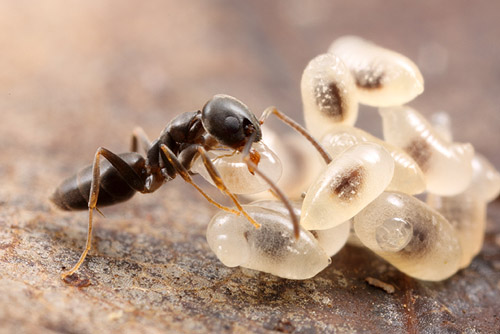Last summer I replaced the old covering on our porch roof. When I peeled back the rotting shingles, I was greeted by a frenzy of frenetic brown ants- thousands of them- running about every which way. Dozens of fat queens scurried for cover. It was an impressive display of formicid infestation, reminiscent of the swarms of invasive Argentine ants in California.
But these weren't exotic pests. This was a native species, Tapinoma sessile, whose pleasant blue-cheese odor lends it the name "odorous house ant".
Tapinoma sessile is found nearly everywhere in North America. I've seen it in alpine meadows near Lake Tahoe, in parking lots in rural Missouri, in desert canyons in Arizona, and along sidewalks in suburban New York. Native meadows and urban jungles alike host populations- it's perhaps the most consistently present ant in North American ecosystems.
In spite of its ubiquity, little is known about the origins of Tapinoma sessile. There are two likely hypotheses for the source of persistently pesty urban populations, though. One is that T. sessile is like many invasive ants- a single lineage particularly well-suited to urban conditions could have spread with human commerce across the continent. If this is true, genetic analyses should show a single clade of urban ants. The second is that T. sessile is naturally pesty and the pest populations are simply local ants thriving in the human landscape. In this case, urban populations should be intermingled among their local counterparts.
Fortunately, we don't have to wait to solve this question. A paper out today in PLoS One by Sean Menke and colleagues provides an answer:

relationships of mtDNA from Tapinoma sessile collected across North America, based on the gene COI (from Figure 3 of Menke et al)
Urban T. sessile is overwhelmingly local, insofar as its mtDNA is concerned. The urban populations are not a single pesty lineage tramping around with trade but are natives doing well in the human-modified landscape. Furthermore, the authors found that the colony structure of urban and rural populations were similar. So the pest colonies may not actually be behaving differently than their rural counterparts. They just live in places where people take notice. Like porch roofs, for instance.
One caveat, though (and there's always a caveat!). This study looked at a single genetic locus, and it's possible that the phylogenetic pattern seen here is a result of repeated introgression of local mitochondria into invasive pest lineages as a result of interbreeding. I don't think it likely, though, considering the persistence of the pattern.
source: Menke SB, Booth W, Dunn RR, Schal C, Vargo EL, et al. (2010) Is It Easy to Be Urban? Convergent Success in Urban Habitats among Lineages of a Widespread Native Ant. PLoS ONE 5(2): e9194. doi:10.1371/journal.pone.0009194
- Log in to post comments


Wouldn't this be a potential caveat whether one or 100 mtDNA sequences were utilized? How can this be overcome?
What a cool paper!
Questions for the general public here;
Anyone suspect what aspect of Tapinoma life history makes them amicable to so many habitats in North America?
I'm no expert on systematics, but when do you start calling these 4 sister clades, potentially, 4 species?
Hello Alex,
I found your website and blog while trying to find out more about my uninvited guests: http://web.me.com/traceybyrne/ANTS
I am wowed by your 5x photos, and hope that you don't mind that I linked to your site from my post.
and I do have a question for you, do you know why odorous house ants are attracted to electrical devices? we've had them swarming in our phone charger, a digital clock, and a cordless drill charger.
thanks for any info you have on this.
Tracey